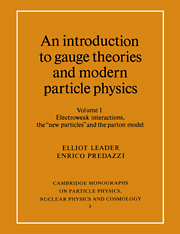Book contents
- Frontmatter
- Contents
- Preface
- Acknowledgements
- Notational conventions
- Note added in proof: the discovery of the top quark (?)
- Note added in proof: the demise of the SSC
- 1 Field theory and pre-gauge theory of weak interactions
- 2 The need for a gauge theory
- 3 Spontaneous symmetry breaking: the Goldstone theorem and the Higgs phenomenon
- 4 Construction of the standard model
- 5 Lowest order tests of the SM in the leptonic sector
- 6 The Higgs boson
- 7 The standard model beyond lowest order
- 8 e+e− physics and the standard model
- 9 Extension to the hadrons; quark–lepton universality
- 10 Phenomenology of semi-leptonic reactions
- 11 The discovery of the narrow vector resonances
- 12 Hidden flavour bound states
- 13 Open heavy flavours
- 14 The heavy lepton τ
- 15 Towards the parton model—deep inelastic scattering
- 16 The quark–parton model
- 17 Experimental tests of the quark-parton model
- Appendix 1 Elements of field theory
- Appendix 2 Feynman rules for QED, QCD and the SM
- Appendix 3 Conserved vector currents and their charges
- References
- Analytic subject index for vols. 1 and 2
10 - Phenomenology of semi-leptonic reactions
Published online by Cambridge University Press: 19 March 2010
- Frontmatter
- Contents
- Preface
- Acknowledgements
- Notational conventions
- Note added in proof: the discovery of the top quark (?)
- Note added in proof: the demise of the SSC
- 1 Field theory and pre-gauge theory of weak interactions
- 2 The need for a gauge theory
- 3 Spontaneous symmetry breaking: the Goldstone theorem and the Higgs phenomenon
- 4 Construction of the standard model
- 5 Lowest order tests of the SM in the leptonic sector
- 6 The Higgs boson
- 7 The standard model beyond lowest order
- 8 e+e− physics and the standard model
- 9 Extension to the hadrons; quark–lepton universality
- 10 Phenomenology of semi-leptonic reactions
- 11 The discovery of the narrow vector resonances
- 12 Hidden flavour bound states
- 13 Open heavy flavours
- 14 The heavy lepton τ
- 15 Towards the parton model—deep inelastic scattering
- 16 The quark–parton model
- 17 Experimental tests of the quark-parton model
- Appendix 1 Elements of field theory
- Appendix 2 Feynman rules for QED, QCD and the SM
- Appendix 3 Conserved vector currents and their charges
- References
- Analytic subject index for vols. 1 and 2
Summary
In the leptonic sector, once we are given the values of α, G and MZ, there are no free parameters left (at least at Born approximation level) so that the entire phenomenology of leptonic reactions is calculable.
In the hadronic sector, matters are not so clear cut. The coupling strengths Vij which involve four parameters are introduced at the quark level. Thus we have to find a convincing way to relate information at the quark level to the calculation of hadronic reactions. This step, in principle, involves the strong interactions and is therefore highly non-trivial. From this point of view the least difficult reactions are the semi-leptonic ones and we shall concentrate upon them in this chapter.
Clearly none of the results of the old Cabibbo theory pertaining to the classic low energy weak interactions discussed in Chapter 1 will be altered, so the most interesting information will come from reactions involving the ‘new’ particles and from high energy weak interactions. For this reason we shall not attempt an analysis of Vij in this chapter. Rather, we shall gather information on the Vij when discussing the discovery and properties of the new particles in the following chapters, in Chapter 18 and in the study of CP violation in Chapter 19.
As always with hadrons the strong interactions play a dominant role, which is largely not understood. Our weak interaction theory is very precise as far as quarks are concerned, but to translate this into precise statements about hadrons requires a model of the quark content of hadrons and the rôle of the quarks in scattering processes.
- Type
- Chapter
- Information
- An Introduction to Gauge Theories and Modern Particle Physics , pp. 182 - 201Publisher: Cambridge University PressPrint publication year: 1996



